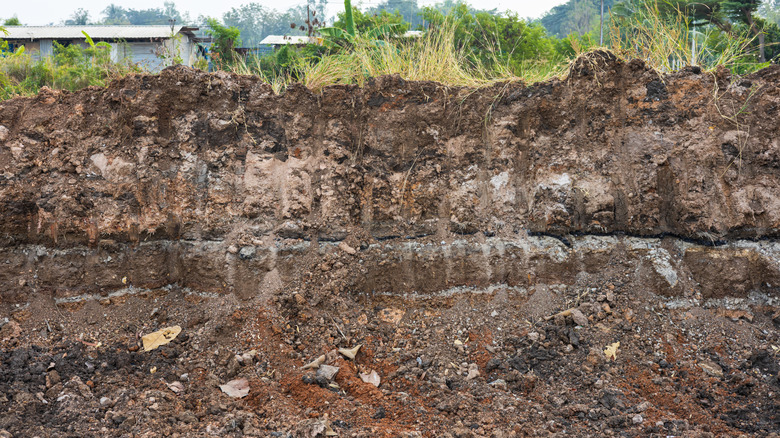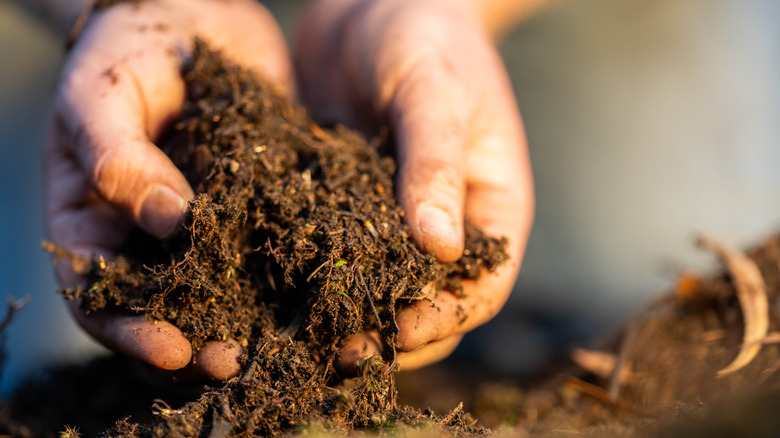How Different Kinds Of Particles Determine Your Garden Soil Type
You've probably read countless seed packets and planting guides that use words like "sandy," "clay," "loam," and "silt" to describe the ideal soil texture for what you're planting. But you might not know exactly what those terms mean or have a grasp on which soil texture prevails in your garden. It all comes down to soil particles, the foundational building blocks for your soil that determine the soil's overall texture. These particles can also define the soil quality — along with soil structure, organic material content, and more.
In general, three main particle types go into making soil: sand, clay, and silt. Loam is soil made up of all three of these particles. Proportions in loam can vary, but a loam mixture of 40% sand, 40% silt, and 20% clay is often considered optimal for plant growth. The three mineral particles come from rock parent material and are classified solely by size. Sand is, by far, the largest, dwarfing clay particles more than 1,000 times over. Silt particles are between sand and clay in size. The relative distribution of each type of particle dictates the overall soil type and texture. Knowing which type of soil you have can help you understand which why some plants thrive in your yard.
Learn about clay, sand, and silt particles
Clay soil is also known as "heavy" soil and is prone to drying out and often forming a crust that is virtually impenetrable by irrigation. Aided by their flat or plate-like shape, in some clays, particles form layers, like laminated pastry, and store nutrients between the layers. Clay soils also hold water between the layers, sometimes to excess, resulting in poor drainage. Relatively small pore spaces between clay particles exacerbates the water retention. Clay soil can be hard to work and is susceptible to compaction. That's why you'll likely benefit from the ultimate guide to improving heavy clay soil in your garden.
In terms of drainage, sand particles are the opposite of clay. Both larger particles and larger pore space around them allow for rapid drainage. Thus, sandy soil is at risk of drought. Sand particles, of course, are loose and distinguishable to the naked eye. They typically hold fewer nutrients than clay particles because they have less surface area for nutrients to cling to. Sand is the dominant particle in coarse soil. If sandy soil is problematic in your garden, you can add amendments to grow more vibrant plants.
Silt appears like dust when dry and is typically more fertile than the other particles. It is characterized by being on the move — blowing onto the plains, flowing on water, and being deposited along the way through riverbanks and deltas. Silt is slick and slippery when it's wet. While top-notch soil needs some silt, excessive silt can disturb ecosystems.
Identify your soil texture in several ways
How can you find out what kinds of particles and overall soil texture you have? At least four ways are available to you, three of them at little to no cost. First, you can figure out your garden soil's type by using just your hand. Soil that is mostly clay may feel sticky or greasy. You can form clay into a ball when wet and even roll it out into a ribbon. Sandy soil feels gritty and loose and will fall apart if you try to roll it into a ball when wet. Silt feels fine like flour and will roll into a ball when wet, but not a ribbon.
Next is the little-known Mason jar hack that can totally up your gardening game – the jar test for soil texture. Sift some of your soil into a jar (doesn't have to be a Mason jar) until it's a third full. Fill the rest of the jar with water, with a bit of space at the top. Place the cap on the jar, shake well, and set it down. After a minute, mark the top of the sand layer sitting at the bottom. Let the jar sit for two hours, and then mark the silt layer on top of the sand. After another 48 hours, the clay layer will have settled on top the silt.
The third way to determine soil texture is to enter your location into the USDA's Web Soil Survey, which enables you to access soil data throughout the United States. Finally, the next time you get a professional soil test done, you can request a "mechanical analysis" of your soil (which will probably require an additional cost). In this process, the soil tester weighs the volume of each type of particle.


